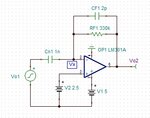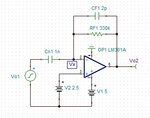simbaliya
Member level 4
Hi, I have below circuit and I am trying to understand its close loop response.
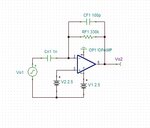
Before simulation I try 2 method to calculate by hand its close-loop transfer function.
method1:
Vo1/(1/S*Cn1) = -Vo2/(RF1//(1/S*CF1))
Vo2/Vo1= -(RF*Cn1*S)/(1+RF1*CF1*S)
it shows there is one zero at zero frequency and one pole at 1/(2*pi*RF1*CF1), which means I should probably see sth like this
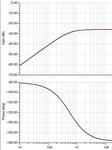
method2:
calculate feedback factor beta first
beta = (1/S*Cn1)/[(1/S*Cn1)+(RF//(1/S*CF1))]
use a second order open loop transfer function for op amp
Ao = Adc/[(1+S/p1)(1+S/p2)]
calculate close-loop response Acl = Ao/(1+Ao*beta), and the result will be very complicated and different compared with method1.
Below is the simulation result, it shows there are 2 poles and 2 zero, which means method1(1 pole and 1 zero) is not accurate enough.
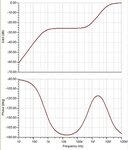
Based on the simulation results, I believe method2 is more reliable. The DC gain and internal poles of op amp play a part to the close-loop response. But I have difficulty to solve pole and zero frequency of method2, it is too complicated, and I am not sure method2 is correct . I need some help here, thanks in advance.

Before simulation I try 2 method to calculate by hand its close-loop transfer function.
method1:
Vo1/(1/S*Cn1) = -Vo2/(RF1//(1/S*CF1))
Vo2/Vo1= -(RF*Cn1*S)/(1+RF1*CF1*S)
it shows there is one zero at zero frequency and one pole at 1/(2*pi*RF1*CF1), which means I should probably see sth like this

method2:
calculate feedback factor beta first
beta = (1/S*Cn1)/[(1/S*Cn1)+(RF//(1/S*CF1))]
use a second order open loop transfer function for op amp
Ao = Adc/[(1+S/p1)(1+S/p2)]
calculate close-loop response Acl = Ao/(1+Ao*beta), and the result will be very complicated and different compared with method1.
Below is the simulation result, it shows there are 2 poles and 2 zero, which means method1(1 pole and 1 zero) is not accurate enough.

Based on the simulation results, I believe method2 is more reliable. The DC gain and internal poles of op amp play a part to the close-loop response. But I have difficulty to solve pole and zero frequency of method2, it is too complicated, and I am not sure method2 is correct . I need some help here, thanks in advance.
Last edited:
